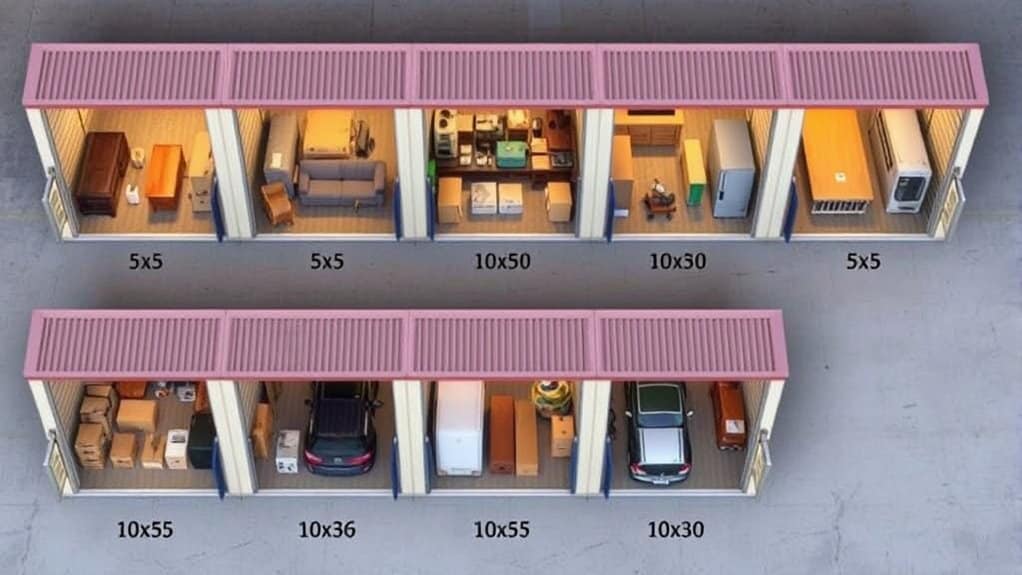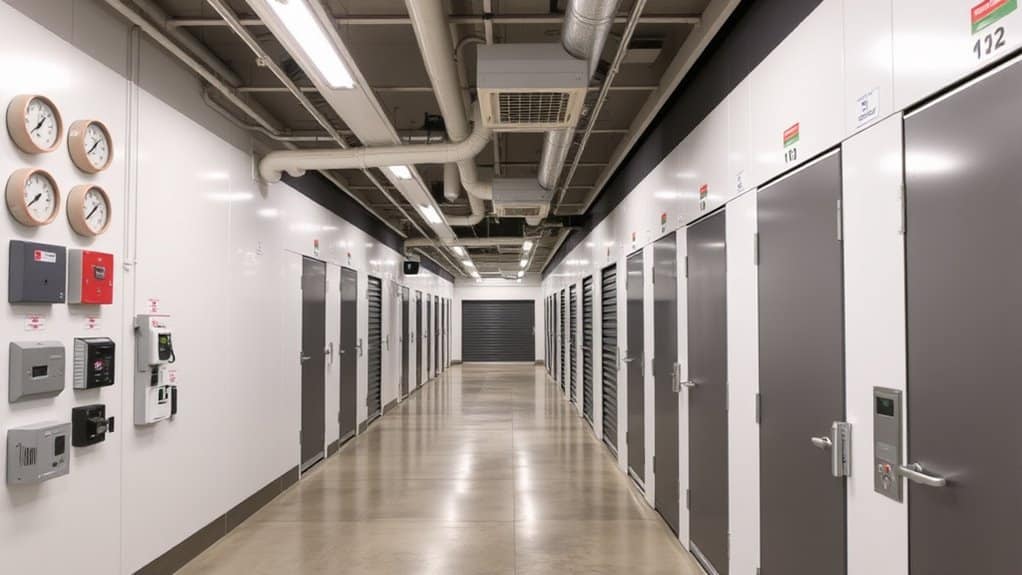To choose the right storage unit size, start by taking detailed measurements of your large furniture pieces and making a complete inventory of items you'll store. Small 5x5 or 5x10 units work for seasonal items, while medium 10x10 units fit contents from a one-bedroom apartment. Large 10x20 or 10x30 spaces accommodate multi-bedroom homes or vehicles. Use online calculators to estimate your needs, and don't forget to take into account climate control for sensitive items. Our extensive sizing guide will help you make the perfect choice.
Common Storage Unit Dimensions and Their Uses

Five standard storage unit sizes serve distinct needs, ranging from compact 5x5 units to expansive 20x20 spaces.
When exploring storage unit types, you'll find small units (5x5 and 5x10) perfect for seasonal items and studio apartment overflow, while medium units (5x15, 10x10, and 10x15) accommodate furniture from one to two bedrooms.
For ideal space utilization, large units (10x20 and 10x30) can house contents from multi-bedroom homes, including oversized furniture and appliances.
The extra-large 20x20 units offer maximum flexibility, equivalent to a two-car garage.
Vehicle storage requires special consideration, with 10x20 units suitable for motorcycles, 10x30 for small cars, and 20x20 spaces accommodating larger vehicles while leaving room for additional household items.
Measuring Your Storage Inventory
Accurate inventory measurement forms the foundation of effective storage unit planning. You'll need systematic inventory tracking to determine the right unit size for your belongings.
Modern tools like barcode systems and RFID tags can help you catalog items precisely, while proper item categorization guarantees you're maximizing every cubic foot of storage space.
- Use the VED analysis method to prioritize your items - identifying essential possessions that need immediate access, crucial items that require regular retrieval, and desirable items that can be stored toward the back.
- Measure large furniture pieces' dimensions carefully, accounting for height, width, and depth.
- Calculate total space requirements by grouping similar items together and leaving pathways for access. Consider short-term storage options if your needs are temporary, as they provide flexible rental terms that may suit your situation.
Consider using inventory tracking apps to maintain a digital record of your stored belongings, making future reorganization easier.
Essential Tools for Space Calculation
Modern online storage unit calculators will help you determine the perfect unit size by analyzing your inventory input and suggesting appropriate options through specialized algorithms.
You'll find these digital tools particularly useful when evaluating your storage needs on-the-go, as they're optimized for mobile devices and integrate directly with storage facility offerings.
While digital calculators offer convenience, you should also keep traditional measurement methods handy, including tape measures and weight estimation tools, to double-check your calculations and guarantee accuracy.
Online Storage Unit Calculators
Online storage unit calculators serve as invaluable digital tools that take the guesswork out of selecting the right storage space for your belongings.
These calculator features allow you to input your items room by room, adjust dimensions for non-standard pieces, and receive real-time unit size recommendations. You'll find the user experience streamlined, with dynamic inventory tracking and visual comparisons that help you understand exactly how much space you'll need.
- Input your inventory systematically through room-by-room categories, making sure you don't forget essential items.
- Receive instant alerts when you're approaching capacity limits, helping you avoid costly storage mistakes.
- Visualize your space requirements with real-time updates, giving you confidence in your unit selection.
Always factor in extra space for last-minute additions and proper item accessibility.
Physical Measurement Methods
When selecting a storage unit, reliable physical measurements form the foundation of an effective space calculation strategy. You'll need a tape measure or laser measuring tool to capture accurate dimensions of your furniture and belongings.
Start by measuring large items like sofas, beds, and dining tables in inches, recording their depth, width, and height.
To guarantee dimensional accuracy, use common reference points to visualize space requirements. For instance, compare larger items to the size of two queen mattresses or assess if furniture pieces will need disassembly.
Don't forget to measure doorways and corridors to confirm accessibility. Your measurement techniques should include allocating space for pathways between items and considering ceiling clearance for stacked boxes.
Remember to group similar items together and estimate the number of boxes you'll need for each category.
Vehicle and Large Equipment Storage Requirements
Selecting the right storage unit for vehicles and large equipment requires careful consideration of three critical dimensions: length, width, and height.
When planning your vehicle types and storage logistics, you'll need to measure from the widest points, including mirrors and accessories, while accounting for door clearance.
- Compact cars and motorcycles typically fit in 10x15 units, making them perfect for standard personal vehicles.
- SUVs and full-size trucks need larger 10x30 spaces to guarantee proper maneuverability.
- RVs and industrial equipment may require specialized units exceeding 50 feet in length.
Remember to verify ceiling heights, as standard units offer 8-9 feet of vertical space.
You'll want to double-check your measurements against unit specifications to avoid costly mistakes, especially if your vehicle has modifications like roof racks or lift kits.
Climate Control and Security Considerations

Although standard storage units offer basic protection, climate-controlled facilities provide essential safeguards for your valuable and sensitive belongings.
The climate control benefits include consistent temperatures year-round and regulated humidity levels, which protect your wooden furniture, electronics, and delicate items from warping, cracking, or deterioration.
You'll find that these units offer enhanced security features through improved insulation and better resistance to moisture-related damage.
While you'll pay about $10 more per month for climate control, this investment can save you money by preserving your items' condition long-term.
If you're storing temperature-sensitive items like antiques, musical instruments, or important documents, you'll want to verify the facility's climate control certification and 24/7 monitoring systems to guarantee your belongings receive prime protection.
Cost Analysis and Value Assessment
Storage unit costs vary considerably based on size, location, and amenities, making it essential to understand current market rates before committing.
When conducting your cost comparison, you'll find that smaller units (5x5-5x15) typically offer the best value at $50-$100 monthly, while larger units can reach $400.
Current pricing strategies show a 24% decrease from 2023, making now an ideal time to secure storage space.
- You'll save $5-30 monthly by choosing longer-term contracts instead of month-to-month agreements.
- Urban facilities charge premium rates, so you might find better deals in suburban locations.
- Don't forget to factor in additional costs like insurance ($10-40 monthly) and transportation expenses when calculating your total budget. Additionally, consider small load movers for efficient transport of your items to the storage unit.
Smart Packing and Organization Strategies
When you're ready to pack your storage unit, you'll want to maximize every inch of vertical space by stacking boxes strategically, with heavier items at the bottom and lighter ones on top.
Clear, detailed labeling on multiple sides of each box will help you quickly locate items without having to move everything around later.
Creating an organized system with properly labeled containers isn't just about convenience - it's about protecting your belongings and making the most of your storage investment. Additionally, protecting belongings from moisture and dust is essential to ensure their condition during storage.
Vertical Space Maximization Tips
Making the most of vertical space stands as one of the smartest ways to maximize your storage unit's potential. By implementing vertical shelving systems and proper ceiling utilization, you'll discover that your unit can hold considerably more than you initially thought.
Smart vertical organization can increase your storage capacity by up to 30%, giving you more bang for your buck.
- Install industrial shelving tiers from floor to ceiling, keeping frequently accessed items at lower levels for easy reach.
- Utilize wall-mounted solutions like pegboards and hooks to keep floor space clear while maximizing storage options.
- Stack uniform boxes strategically, with heavier items at the bottom and a clear labeling system to track contents.
Additionally, consider using climate-controlled storage to preserve delicate items that may be sensitive to temperature fluctuations.
Remember to secure all vertical storage solutions properly and stay within your unit's height limits to maintain safety while maximizing space efficiency.
Box Labeling Best Practices
Proper box labeling serves as the foundation for an efficiently organized storage unit, making the difference between quick item retrieval and frustrating searches.
Start with effective labeling techniques by using color-coding systems and permanent markers to guarantee visibility optimization in dimly lit spaces. You'll want to position labels centrally on all exposed sides of boxes, using large, bold fonts that you can read from a distance.
For long-term durability, protect your labels with clear packing tape or lamination, especially in humid environments. List contents concisely, include priority levels, and note any special handling requirements.
Don't forget to implement a numeric system that cross-references with your inventory records. Review and update labels quarterly, keeping your organization system current as your storage needs change.
Conclusion
Choosing the right storage unit doesn't have to be complicated. When you're ready to make your selection, remember to measure your items carefully, consider your long-term needs, and factor in climate control requirements. You'll save time, money, and stress by planning ahead, staying organized, and selecting the appropriate size from the start. With these guidelines in mind, you're well-equipped to make a smart storage decision that fits your budget and needs.



